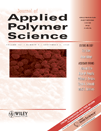Assembly of polyelectrolyte multilayers on nylon fibers
Abstract
Non-woven nylon fibers were investigated as a new type of substrate for the deposition of polyelectrolyte multilayers (PEM) thin films. PEM assembled from cationic poly(diallyldimethylammonium chloride) PDADMAC, and anionic Scarlet dye (λmax absorbance = 510 nm) were deposited directly on Nylon fibers and characterized using a reflectometer spectrophotometer. Evidences of the film assembly are presented as well as a study of the factors controlling the growth of the PDAMAC/dye PEM film on the fiber. The relation between the sorption coefficient (K) and the scattering (S) extracted from the reflectance data is commonly used to represent the dye fixation or the dye content of a given textile fiber. The increase in K/S value at 510 nm was correlated with the dye deposition and was found to increase linearly with the number of layers. The effect of increasing number of layers, ionic strength of the solutions, concentration of chemicals, and dipping time on the film growth was investigated. Our results show that while increase in dye and PDADMAC concentrations from 0 to 1 mM enhance the deposition process, further increase in PDADMAC concentration to 50 mM led to a decrease in K/S value. The optimum salt concentration for the PDAMAC/dye film growth was found to be 0.5M and dipping times as short as 15 s were found to be sufficient for the deposition of the PEM. © 2006 Wiley Periodicals, Inc. J Appl Polym Sci 101: 3286–3290, 2006




